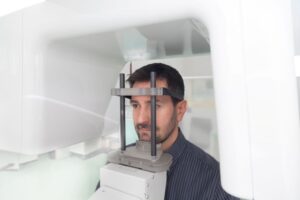
A cone beam computed tomography (CBCT) scanner is a sophisticated piece of equipment that can cost tens of thousands of dollars. Yet, more and more TMJ dentists are investing in such a scanner in order to elevate the level of care they provide. What role might a CBCT scanner play in helping you find long-term relief from jaw pain and other symptoms of TMJ disorder (TMD)? This blog post provides helpful information.
What Is a CBCT Scanner?
A CBCT scanner is essentially an advanced type of X-ray machine. It uses a cone-shaped beam of radiation to capture highly detailed, three-dimensional images of the targeted area. It can help your dentist to gain important information about your teeth, jaws, nerves, and connective tissues. CBCT images provide much more information than traditional digital X-rays.
The Role of CBCT Scans in TMJ Treatment
TMD is a complex condition, and there is no “one size fits all” solution to it. In order for your treatment to provide long-term results, it should be geared toward your unique situation. Ideally, it should address the underlying cause of your condition, rather than just your symptoms.
However, your dentist cannot determine the cause of your TMD unless they have access to adequate information! That is where the CBCT scanner comes into play. It can help your dentist understand the state of your jaw joints and the surrounding tissues. The images can reveal issues like inflammation, disc displacement, bone abnormalities, and more.
Once your dentist understands why you are in pain, they can design a custom plan for your case. After you start treatment, additional CBCT scans can help to track the effectiveness of your therapy.
What to Expect with a CBCT Scan
The scanning process is fast, easy, and safe. Here are some highlights of how it works:
- All you have to do is remain still while the machine does its job.
- Depending on which area is being scanned, it might take just a minute or so to capture the needed images.
- Although a CBCT machine uses more radiation than a digital X-ray, it still uses much less than a traditional CT scan. It is a very safe imaging method!
- Your dentist can access the captured images right away and start to analyze the state of your oral structures.
Cone beam scanning can play a big role in your journey toward TMD relief! Ask your dentist if you have questions about this remarkable piece of technology.
Meet the Practice
Dr. Brandon Brunner is an experienced dentist who has a special passion for treating TMJ disorder and sleep apnea. He has completed hundreds of hours of continuing education. Our practice uses top-tier technology, including a CBCT scanner, with the goal of providing top-quality care to our patients. If you would like to learn more about us and how we may be able to serve you, get in touch with our Wauwatosa office at 414-966-7639.


